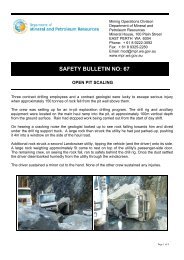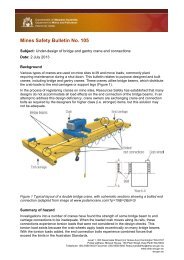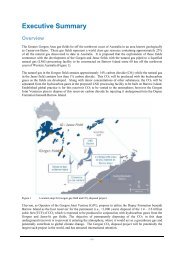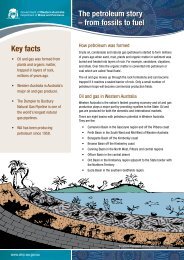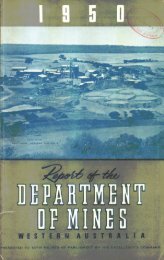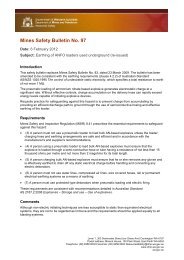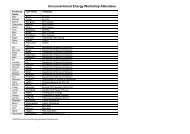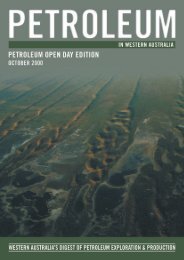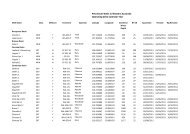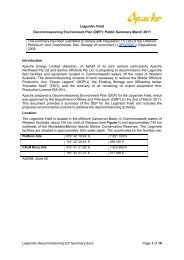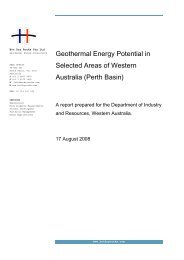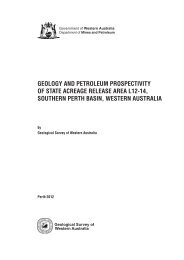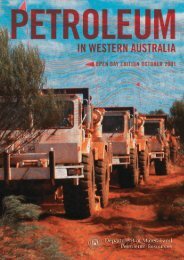IN WESTERN AUSTRALIA - Department of Mines and Petroleum
IN WESTERN AUSTRALIA - Department of Mines and Petroleum
IN WESTERN AUSTRALIA - Department of Mines and Petroleum
Create successful ePaper yourself
Turn your PDF publications into a flip-book with our unique Google optimized e-Paper software.
26<br />
PWA April Edition - Magnetotelluric Surveys<br />
Empire decided to contact the company responsible<br />
for carrying out the survey <strong>and</strong> contracted DMT, to<br />
carry out a new MT survey starting in November<br />
2000 to evaluate a number <strong>of</strong> other prospects that<br />
had been identified from the re-interpretation <strong>of</strong> the<br />
seismic data. The prospects identified included<br />
small four-way dip closures on the Rough Range<br />
anticline, (the largest named Brooke); a large fault<br />
dependent closure at the northern end <strong>of</strong> the<br />
anticline updip <strong>of</strong> Lefroy Hill 1 (Tess); a fault<br />
dependent closure to the east <strong>of</strong> the Rough Range<br />
fault (Jennifer); <strong>and</strong> updip <strong>of</strong> Parrot Hill 1 (Elysia).<br />
The survey was carried out between 10 November<br />
<strong>and</strong> 4 December 2000 by DMT technologies under<br />
the supervision <strong>of</strong> Empire Oil & Gas. Field<br />
operations went very smoothly with very few hitches<br />
<strong>and</strong> overall productivity was on average 30% higher<br />
than expected, which enabled additional programme<br />
to be recorded. After the first two days recording,<br />
Empire undertook the acquisition programme<br />
leaving the DMT operator, Bob Mecionis, to<br />
concentrate on the analysis <strong>of</strong> the data. The main<br />
advantage <strong>of</strong> this method <strong>of</strong> operation to Empire<br />
was the flexibility to be able to change the<br />
programme as preliminary results were obtained.<br />
The ability to be able to record data on any<br />
particular day was subject to the vagaries <strong>of</strong> solar<br />
weather. A total <strong>of</strong> 165 points were recorded –<br />
approximately 60 more than was originally planned.<br />
The Rough Range area is well suited to the MT<br />
method due to the sharp contrast between the<br />
saline Birdrong reservoir <strong>and</strong> the overlying shales<br />
<strong>and</strong> also due to the ideal ground conditions.<br />
DMT were provided with log data from the Rough<br />
Range 1A well. Analysis <strong>of</strong> all other points was done<br />
without prior knowledge <strong>of</strong> any existing<br />
interpretation or <strong>of</strong> the results <strong>of</strong> the other wells<br />
recorded. The initial test programme consisted <strong>of</strong> a<br />
line across the Rough Range field including the<br />
Rough Range 1A well plus points recorded at the<br />
following wells – Rough Range 6, Rough Range 10,<br />
Rough Range 11, Central Rough Range 1, Rough<br />
Range 2 <strong>and</strong> Rough Range 7. Interpretation <strong>of</strong> the<br />
line over the field confirmed the existing<br />
interpretation within expected margins <strong>of</strong> error for<br />
both structure <strong>and</strong> fluid content. For the additional<br />
well points the Z-scan plots accurately identified the<br />
top <strong>of</strong> the Birdrong to an accuracy <strong>of</strong> +/- 3 m <strong>and</strong><br />
identified fluid content <strong>and</strong> column heights with<br />
complete accuracy. The author can personally<br />
confirm that these results were obtained in strict<br />
‘blind test’ conditions. In addition, the top reservoir<br />
was an unambiguous pick on all the analysed plots,<br />
thin zones within the Windalia Radiolarite typically<br />
gave a weak oil responses followed by a bl<strong>and</strong><br />
medium to high electromagnetic (EM) impedance<br />
response through the Muderong Shale followed by a<br />
sharp kick to a low EM impedance zone<br />
corresponding to the Birdrong S<strong>and</strong>stone, which<br />
gave either a strong water response sometimes<br />
preceded by a few metres <strong>of</strong> an oil response. It was<br />
concluded that the method appeared to be working<br />
to better than expectations <strong>and</strong> that the remainder<br />
<strong>of</strong> the survey should proceed as planned <strong>and</strong><br />
possibly exp<strong>and</strong>ed.<br />
The main results <strong>of</strong> the remainder <strong>of</strong> the survey,<br />
were that the Brooke, Tess, Elysia <strong>and</strong> Jennifer<br />
prospects all yielded encouraging results in terms <strong>of</strong><br />
picked depths <strong>and</strong> predicted oil columns.<br />
Recordings over a number <strong>of</strong> other minor leads <strong>and</strong><br />
prospects (e.g. a lead updip <strong>of</strong> Roberts Hill 1) all<br />
gave negative results. A number <strong>of</strong> other wells were<br />
analysed <strong>and</strong> these mostly gave consistently good<br />
correlations although the oil column <strong>of</strong> 3-6 m (from<br />
logs) in Parrot Hill was not identified <strong>and</strong> there was<br />
a depth error <strong>of</strong> 12 m at Lefroy Hill 1. The updip<br />
Parrot Hill prospect, Elysia, was affected by steep<br />
dip <strong>and</strong> it was found to be necessary to h<strong>and</strong><br />
migrate the results using shallow dips derived from<br />
the seismic data to obtain a more meaningful map.<br />
It was subsequently decided to test the most<br />
promising prospect, Brooke, identified from the MT<br />
survey. This prospect was relatively small in size but<br />
predicted to be about twice as large as the Rough<br />
Range field. It was about 400 m from Rough Range<br />
7 which had good oil shows but was poorly<br />
controlled by seismic <strong>and</strong> what seismic there was,<br />
was affected by a strong velocity field. Unfortunately,<br />
Brooke 1 came in low to prognosis <strong>and</strong> was dry. It is<br />
interpreted that the well was just on the wrong side<br />
<strong>of</strong> a normal fault running perpendicular to the Rough<br />
Range fault <strong>and</strong> sub-parallel to the nearby 2D<br />
Drilling operations at Rough Range (image courtesy <strong>of</strong> Empire Oil <strong>and</strong> Gas)



